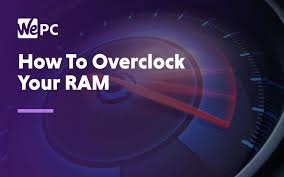After reading the title of this article, you all must be wondering what it is all about! This article will target the frequently asked question: How to overclock RAM? This is the first time for some people to hear this term. Thus, we will first learn more about RAM Overclocking before diving deep into the main topic: How to overclock RAM?
Let’s get started!
Table of Contents
What is RAM Overclocking? How can we overclock RAM?

Our computer teacher taught us about RAM. In case you forgot, let me rephrase that for you! RAM, aka Random Access Memory, is a computer device or system that allows users to read, write or edit their data. Moreover, you may store Several machine languages and other data items under this memory.
Overlocking is the most common term generally used when we talk about GPUs or CPUs. However, it is possible to overclock Ram too.
Overclocking is increasing the clock speed so that the performance could improve. Moreover, Overclocking is the result of making certain changes in the rate, Voltage, and timing to give excellent results in a short time.
Is it okay to overclock RAM?
For some people, Overclocking is taboo. Some people think it is dangerous to overclock RAM. It can affect the computer or can even destroy it. However, it has been certified that it is safe to overclock RAM. Instead, it can affect the performance of your PC positively. It increases the speed so that all the time-consuming tasks can be done within seconds or minutes. Furthermore, it is equally important not to increase the Voltage. This can have bad consequences.
Ideal Voltage to overclock RAM
It is advisable not to increase the Voltage as it can have dire consequences. The main question is, what the ideal overclocking Voltage is? It is advisable to keep the Voltage lower than 1.5 Volts. This is because the circuit boards of several computers do not support 1.5 volts of Voltage. Moreover, please make sure to keep the Voltage very low while testing. Also, if you set the voltage too high, there are chances that your system will not boot.
How do RAM overclocking works?
The processor uses the information which RAM stores. This information gets transferred to RAM whenever needed. This data transmission can be carried out in a blink of an eye if you overclock RAM.
The higher the RAM speed, the more efficiently the processor works. Also, this will improve the performance of your system.
Moreover, the performance of the RAM depends upon two main characteristics: latency/ timings and frequency. These two factors work indirectly with each other. If the frequency is higher, the performance will increase. On the other hand, latency should remain low. Latency means the time taken to carry out a task. Therefore, the lesser the time, the more efficient the task.
Relationship between Frequency and Latency
The two main characters, frequency and latency, determine the performance of the RAM. Low latency and high frequency are just what you need to overclock RAM. However, the frequency should not be too high. This is because it becomes difficult to handle the speed at the highest frequency level. Therefore, it becomes important to increase the latency to keep stability and balance.
Yes, you are correct! Of course, the high latency will delay the operations. However, the system will remain stable.
Therefore, the developers remain extra cautious while overclocking the RAM. For this, they carefully select the best memory that can give maximum performance at high frequencies. Of course, this high frequency and stable clock take the manufacturers extra time and effort. Therefore, it is a bit expensive for the users.
As I mentioned above, frequency and latency work together but are opposite. However, frequency always overshadows latency if we talk about performance.
Create a Baseline
Before you plan to overclock your RAM, creating a baseline or setting up reference points is important. This will help you to compare the performance results and decide better.
Certain software such as MaxxMEM2, Aida64, memetest86+, Performance tester, etc., are available to set up a benchmark to create a baseline.
Once the benchmarks are set, you are ready to start the process of overclocking. Further, we will discuss the different techniques for overclocking RAM at beginner, intermediary and advanced levels.
You may choose either of the processes depending upon whichever suits you.
Process of Overclocking: At the Beginner level

This is the best process if you are a beginner. Intel XMP is one of the best devices that helps you to achieve high frequency. This is because most circuit boards have pre-determined settings that make them compatible with Intel XMP. Once the system detects Intel XMP, it will automatically manage the frequencies and latencies. In this way, it becomes easier to overclock RAM.
You need to enter your system’s BIOS to reach Intel XMP and make changes. Once you open BIOS, the system will allow you to toggle between profiles. This helps you to overclock at different stages. Choose the one which you think is better for your system. Also, keep the memory and circuit board under consideration to get stable and fast performance.
Once you select the appropriate profile, save the changes. Now, reboot your system, and you are good to go! You need to follow these settings mentioned below:
- Frequency: upto 3200 MHz.
- Latency: 14-(14)-14-34.
- Voltage: Upto 1.35 Volts.
Use these settings and reboot your PC. Once done, revisit the pre-determined benchmarks and try again.
Moreover, the free trial is available on Aida64. Please make sure that the score remains between 32-46 GB/seconds and approximately timing. 47- 60 nanoseconds once we activate the Intel XMP.
Process of Overclocking: At the intermediary level

The only drawback to using Intel XMP is that it lacks customization and flexibility. Also, the overclocking settings with the help of circuit boards are mostly available on high-end circuit boards. This is a bit complicated method for the users. Therefore, it is advisable not to follow this if you are a beginner.
This section requires you to twist some memory settings in your system. For this, you need to access your system’s BIOS and look for the memory profile menu.
Explore the circuit board attestation if you cannot find the memory profile menu. Once you find the section successfully, you are free to explore the different timings, voltages, and frequencies. Or if you are confused as to which option should I choose. Try selecting several combinations and test them. This will help you better judge which is the ideal speed for your motherboard. Please make sure that you choose the correct rate for your circuit boards. This is because not every circuit board could handle such high frequency.
The ideal speed as per the test remains between 50-53 GB/s with a latency of 40-45 nanoseconds. Also, please make sure not to increase the memory load, as this may affect the speed and performance.
Process of Overlocking: At the advanced level

If you are a tech expert looking for something more detailed and advanced than Intel XMP or memory files, manual changes are your thing! However, this will be tiring and time taking. Several professionals spend hours on the system to overclock RAM. But, this is the best and most efficient technique to increase the efficiency of their system.
This process involves accessing the memory profile in BIOS and trying every combination manually until you find the suitable one for your motherboard.
Below are the points to keep in mind while following this process:
- Increasing the Voltage and lowering the latency will help stabilize the high frequency.
- If the frequency is stable and timings are tight, performance will increase definitely.
- The memory settings consist of the array of latency. You may select the best one that suits your system.
- Moreover, Please make sure that the timings pre-mentioned on BIOS are default. For example, if the timings are 16-16-36, you can change it to 15-15-34.
- Once you choose the suitable latency, the next thing is to select the appropriate Voltage. Overclocking your RAM will result in energy and heat consumption to a great extent.
- To achieve a stable overclock Voltage, 1.5 Volts is the standard for overclocking. However, the experts advise us to keep it low, especially during testing.
- Not all circuit boards support high Voltage. There are chances that your system will not boot if you maintain a high voltage.
- Thus, it is recommended to take baby steps while making changes. Also, please aim for stability while making any changes.
Conclusion:
This is all about the RAM and how to overclock RAM. I hope you find this article worth reading. Thank you for your time and take care. We will get back to you with another interesting and worth-reading topic.






